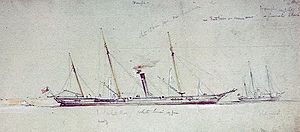HMS Beagle (1854) facts for kids

HMS Beagle and Wrangler by Sir Oswald Brierly, 1855
|
|
Quick facts for kids History |
|
|---|---|
| Name | Beagle |
| Ordered | 10 April 1854 |
| Builder | C J Mare & Company, Leamouth, London |
| Cost |
|
| Laid down | 15 April 1854 |
| Launched | 20 July 1854 |
| Commissioned | 3 September 1854 |
| Fate | Sold to the Satsuma Domain in 1863 |
| Name | Kenko (乾行) |
| Acquired | 1863 |
| Fate | Broken up in 1889 |
| General characteristics | |
| Class and type | Arrow-class gunvessel |
| Displacement | 586 tons |
| Tons burthen | 476 68⁄94 bm |
| Length | 160 ft (48.8 m) |
| Beam | 25 ft (7.6 m) |
| Draught | 11 ft 8 in (3.6 m) (aft) |
| Depth of hold | 13 ft 3 in (4.0 m) |
| Installed power | 160 nhp |
| Propulsion |
|
| Sail plan | Barque-rigged |
| Complement | 65 |
| Armament |
|
HMS Beagle was a special kind of ship called a gunvessel. It was made of wood and used a screw propeller to move, along with sails. Launched in 1854, she was the third ship in the British Royal Navy to be named Beagle. She was later sold in 1863.
Contents
Building the Beagle
During the Crimean War (1853-1856), the Royal Navy needed new ships. They especially needed ships that could sail in shallow waters. These ships had to be easy to steer. This was important for fighting close to shore in places like the Baltic Sea and the Black Sea.
Arrow-Class Ships
Beagle was part of a group of six ships called the Arrow class. All these ships were made of wood and used steam power. They were built in 1854. The design for these ships came from the Royal Navy's Surveyor's Department.
Two companies in London, R & H Green and C J Mare & Company, built these ships. They were first meant to be "despatch vessels." This means they would carry messages or important people quickly. But in 1856, they were renamed "second-class gunvessels."
How the Beagle Moved
The Beagle had a steam engine to help it move.
- It had a two-cylinder engine.
- This engine gave the ship 160 horsepower.
- It turned a single propeller to push the ship through the water.
The Beagle also had sails. It was rigged like a barque. This means it had at least three masts. The front two masts had square sails, and the back mast had fore-and-aft sails.
Ship's Weapons
The Arrow-class ships, including Beagle, carried powerful guns.
- They had two large 68-pounder Lancaster guns. These were special rifled guns that could turn on a pivot.
- They also had four smaller 32-pounder guns.
Beagle's Journey and Service
Beagle was built very quickly. She was started on April 15, 1854. Just a few months later, she was launched on July 20, 1854. She officially joined the Royal Navy on September 3, 1854.
Fighting in the Crimean War
Beagle played a part in the Crimean War from 1854 to 1856. During this war, two brave sailors from Beagle received a very special award. This award was the Victoria Cross (VC). It is the highest award for bravery in the British military.
- Joseph Trewavas earned the VC for his actions in the Sea of Azov.
- William Hewett, who was an acting-mate on Beagle, also received the VC. He earned it for defending a shore battery.
In 1863, Beagle was sold. She went to the Satsuma Domain in Japan. This was a powerful area in Japan at the time. They used her as a training ship. In 1865, her name was changed to Kenko. The ship was eventually taken apart in 1889.

